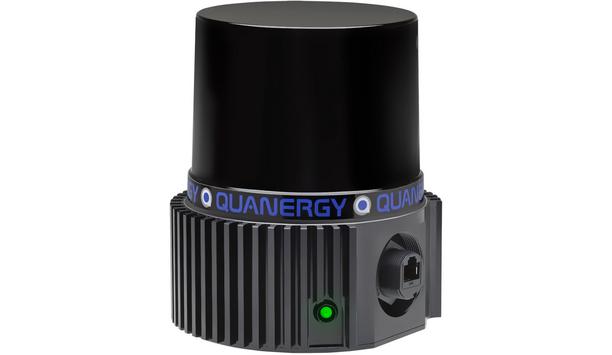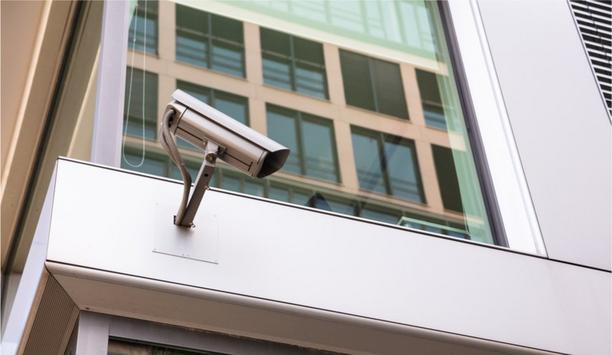Quanergy Systems, Inc. - Experts & Thought Leaders
Latest Quanergy Systems, Inc. news & announcements
Quanergy Solutions, Inc., the pioneer in high-performance 3D LiDAR security and smart space solutions, is showcasing its comprehensive portfolio of hardware and software solutions for both outdoor and indoor applications at ISC West 2025 booth #29081. Featured products include: Q-Track 2.4 software with powerful AI-driven insights; Q-Track LR for long range intrusion detection and perimeter protection; Q-Track HD for optimal detection, tracking and classification in challenging environments like airport terminals, retail stores and office buildings; and Q-Track Dome to track and classify people in smaller and more complex environments, such as corridors, mantraps, and line queues. Quanergy’s 3D LiDAR solution “Quanergy’s uniquely integrated hardware and software 3D LiDAR solution delivers a new dimension of precise, real-time 3D spatial intelligence that seamlessly extends the reach of existing video systems with the most accurate object identification, classification and tracking solution available in any environment,” said Gerald Becker, VP of Market Development & Alliances at Quanergy Solutions, Inc. “This unified approach provides security integrators and end users with a robust platform for enhanced security and business intelligence.” Quanergy’s line of outdoor and indoor 3D LiDAR sensors Q-Track 2.4 software delivers intelligent 3D LiDAR processing that enhances security and smart space analytics Q-Track 2.4 software delivers intelligent 3D LiDAR processing that enhances security and smart space analytics with powerful AI-driven insights across Quanergy’s line of outdoor and indoor 3D LiDAR sensors. This latest software update introduces sophisticated algorithms that enable hyper-accurate continuous object tracking while achieving an impressive 95% reduction in false alarms. The refined perception technology optimises performance across security and crowd management applications, significantly lowering the total cost of ownership for end users. Key features of Q-Track 2.4 Advanced AI-Powered Algorithms: Provides instant alerts for unauthorised access, perimeter breaches, tailgating, and suspicious movement patterns. Enhanced Crowd Behaviour Analytics: Enables detailed people movement analysis for optimised foot traffic management in high-density environments. Seamless Multi-Sensor Fusion: Integrates multiple 3D LiDAR units into a unified system for comprehensive security coverage. Optimised Indoor and Outdoor Performance: Adaptive calibration algorithms ensure smooth operation in varied lighting and weather conditions. Simplified Deployment: User-friendly semi-automatic floor alignment and improved calibration tools streamline installation and operation. Quanergy’s lineup of 3D LiDAR sensors Q-Track LR is purpose-built for long-range perimeter intrusion and object detection in expansive outdoor environments such as critical infrastructures, data centres, commercial sites, and transportation hubs. With its extended range and 360-degree horizontal field of view, Q-Track LR can monitor vast perimeters, accurately identifying and tracking potential intrusions or objects over considerable distances, even in low-visibility conditions. Integrated into a meshed network, multiple Q-Track LR units provide seamless coverage, ensuring that assets and sensitive areas are secured against unauthorised access and potential threats. Q-Track HD is designed to provide optimal tracking and classification in challenging environments, such as airport terminals, retail stores and office buildings. With its 360-degree horizontal field of view and very wide vertical field of view, a meshed network of Q-Track HD’s can accurately track over 1000 people simultaneously, while they walk around obstructions such as line queues, columns, shelves, desks, etc. Q-Track Dome is designed to track and classify people in even smaller and more complex environments, such as corridors, mantraps, and line queues with a 90-degree vertical field of view. This sensor is optimised for dense areas, offering unmatched performance and reliability for object tracking and crowd intelligence gathering applications. Range of 3D LiDAR solutions ISC West 2025 attendees are invited to visit Quanergy Solutions at stand #29081 for live demonstrations of the company’s complete range of 3D LiDAR solutions. Quanergy will also be showcasing its integration with Avigilon Unity at the Motorola Solutions booth #14059 on April 4 between 10:00 a.m. and 12:20 p.m.
Quanergy Solutions, Inc., the pioneer in high-performance 3D LiDAR security and smart space solutions, is highlighting its expanded integrations with industry-leading security partners Hanwha Vision and Avigilon at ISC West 2025 booth #29081. The integration of Quanergy’s advanced 3D LiDAR solutions with Hanwha’s Wisenet WAVE 6.0 VMS and Motorola’s Avigilon Unity On-Premise Video Security Platform delivers enhanced perimeter security, intrusion detection, and object classification capabilities for enterprise and critical infrastructure customers. 3D LiDAR and video solution Quanergy at booth #29081 to learn more about the company’s partnerships and 3D LiDAR security solutions “Quanergy’s integration with Hanwha’s Wisenet WAVE 6.0 VMS and Motorola’s Avigilon Unity platform establishes new benchmarks in intelligent security and business intelligence performance,” said Gerald Becker, Vice President of Market Development and Alliances at Quanergy. “We’re delivering a unified 3D LiDAR and video solution that empowers enterprise and critical infrastructure customers with unparalleled situational awareness, enabling proactive threat detection and mitigation and improved operational excellence.” Quanergy’s integration with Avigilon Unity enables: Real-time insights through combined 3D LiDAR and video analytics Edge-based intelligence that proactively alerts security personnel of potential security events Enhanced search capabilities for people or vehicles using both 3D LiDAR and video data Streamlined decision-making with standard operating procedures that incorporate 3D LiDAR detection Seamless access to 3D LiDAR detection events via Unity’s cloud platform and mobile application Quanergy’s integration with Hanwha’s Wisenet WAVE 6.0 VMS enables users to: View 3D LiDAR-detected events directly within the Wisenet WAVE interface Utilize camera linking hotspot/teleport features to automatically direct PTZ cameras to 3D LiDAR-identified targets Receive real-time alerts for security events with 3D visualization Minimize false alarms through Quanergy’s advanced classification algorithms Attendees can visit Quanergy at booth #29081 to learn more about the company’s partnerships and 3D LiDAR security solutions. Visit the Avigilon booth #14059 on April 4 between 10:00 AM and 12:20 PM for a live demo.
Quanergy Solutions, Inc., a provider of 3D LiDAR solutions, announces the full integration of its Q-Track™ 3D LiDAR platform with Bosch Video Management System (BVMS), a modular security system designed to manage video, audio, and data across large-scale security operations. This integration enables seamless interoperability between Quanergy’s high-precision LiDAR object detection and real-time tracking capabilities and Bosch’s industry-pioneer video management platform — allowing operators to make faster, more informed decisions in critical security environments. Critical security environments This integration enables seamless interoperability between Quanergy’s high-precision LiDAR object detection By combining the power of Quanergy Q-Track LiDAR with Bosch BVMS, operators can now access real-time 3D detection and tracking of objects, instantly paired with high-definition video verification from Bosch cameras. Additionally, the integration enables automated PTZ (pan-tilt-zoom) control, allowing cameras to dynamically follow detected objects in real time — significantly enhancing perimeter security and response efficiency. “Integrating our Q-Track platform with Bosch BVMS delivers significant advantages for enhanced perimeter security,” said Gerald Becker, VP Market Development & Alliances of Quanergy Solutions, Inc. “This collaboration empowers security teams to unify real-time 3D LiDAR tracking with high-quality video management, driving faster response times, significantly improving operational efficiency.” Time-consuming false alarms The integration of Quanergy Q-Track with Bosch BVMS delivers several key security benefits: Real-Time Object Detection & Video Verification: Quanergy’s LiDAR technology provides precise real-time detection and tracking of people and vehicles, while BVMS instantly pairs those detections with high-definition video from Bosch cameras for visual verification. Automated PTZ Camera Control: When Q-Track detects a person or vehicle crossing a defined perimeter, Q-Track can automatically direct Bosch PTZ cameras to zoom in and follow the object in real time. This ensures continuous visual coverage without requiring manual camera control, allowing operators to focus on rapid decision-making. Event-Based Triggers: The integration enables Q-Track to initiate event-based actions such as activating alarms, lights, or audible alerts when unauthorised movement is detected — significantly reducing response times. Streamlined Operator Workflow: Security operators can now manage all video feeds, LiDAR alerts, PTZ controls, and event responses through the familiar Bosch BVMS interface, simplifying operations and reducing the risk of missed incidents. Scalable and Resilient Infrastructure: Leveraging BVMS’ enterprise capabilities, operators can manage large-scale deployments across multiple sites, integrating LiDAR detection and video verification across thousands of cameras and locations. Minimised False Alarms: Q-Track’s 3D LiDAR perception software combined with Bosch’s high-resolution video allows operators to verify threats instantly, reducing costly and time-consuming false alarms. Strengthening perimeter protection “The ability to automatically control PTZ cameras based on real-time 3D LiDAR tracking is a game-changer for security operations,” said Becker. “This integration with Bosch BVMS not only strengthens perimeter protection but also improve response times — ensuring that security operators never miss critical events.” This integration is now available for all Quanergy Q-Track and Bosch BVMS users.
Insights & Opinions from thought leaders at Quanergy Systems, Inc.
Casinos offer several attractive applications for LiDAR, including security and business intelligence. Using laser sensors, the technology can replace the use of surveillance cameras. For casino security, LiDAR can track player movement and provides complete coverage and accuracy that have not been achievable by surveillance cameras. Massive coverage areas can save on costs of sensor deployment versus other technologies. LiDAR and its applications LiDAR is a method for determining ranges by targeting an object with a laser and measuring the time for the reflected light to return to the receiver. LiDAR sensors emit pulsed light waves into a surrounding environment, and the pulses bounce off surrounding objects and return to the sensor. The sensor uses the time it took for each pulse to return to the sensor to calculate the distance it travelled. LiDAR is commonly used in markets such as robotics, terrestrial mapping, autonomous vehicles, and Industrial IoT (Internet of Things). Today, casinos offer a lucrative emerging market for technology. LiDAR tracking enables casino operators to understand the guest path, journey, queue time, count Crowd management LiDAR can contribute to a casino’s guest experience by counting people at doors or in sections of the gaming floor to provide intelligence about crowd size to track occupancy. LiDAR tracking enables casino operators to understand the guest path, journey, queue time, count, and other statistical information by comparing previous time frames to current occupancy levels. This approach allows them to understand digital media advertisement and experience placement. Aid in advertisement “Inside a casino, sensors are deployed like surveillance cameras,” says Gerald Becker, VP of Market Development & Alliances, Quanergy. “But instead of security, they are used to provide anonymous tracking of all people walking through the gaming floor. We can get centimetre-level accuracy of location, direction, and speed of the guests. With this data, we can access the guest journey from the path, dwell count, and several other analytics that provides intelligence to operations and marketing to make better decisions on product placement or advertisement.” Quanergy Quanergy is a U.S.-based company that manufactures its hardware in the USA and develops its 3D perception software in-house. Quanergy has various integrations to third-party technology platforms such as video management systems (VMSs) in security and analytics for operational and business intelligence. Perimeter security Sensors can be mounted to a hotel to monitor for potential objects being thrown off the hotel LiDAR is deployed in both exterior and interior applications. For the exterior of a casino or resort, sensors can be mounted to a hotel to monitor for potential objects being thrown off the hotel, or people in areas where they should not be. For example, they can sense and prevent entrance to rooftops or private areas that are not open to the public. Some clients install sensors throughout the perimeter of private property to safeguard executives and/or a VIP’s place of residence. Flow tracking and queuing capabilities Tracking crowd size can initiate digital signage or other digital experiences throughout the property to route guests to other destinations at the property. It can also help with queue analysis at the reservation/check-in desk or other areas where guests line up to tell operations to open another line to maintain the flow of guests passing. Flow tracking and queuing capabilities help casino operators to understand which games groups of customers frequent and allow for the optimisation of customer routing for increased interaction and playtime on the casino floor, quickly impacting the financial performance and return of the casino. No privacy concerns LiDAR provides a point cloud; its millions of little points in a 3D space create the silhouettes of moving or fixed objects The main hurdle right now is market adoption. LiDAR is an emerging technology that is not so widely known for these new use cases, says Becker. “It will take a little bit of time to educate the market on the vast capabilities that can now be realised in 3D beyond traditional IoT sensors that are available now,” he comments. One benefit of LiDAR is that it poses no risk of personally identifiable information (PII) and therefore no privacy concerns. No PII is captured with the technology. Cameras can capture images and transmit them over the network to other applications. However, LiDAR provides a point cloud; its millions of little points in a 3D space create the silhouettes of moving or fixed objects. IoT security strategy There is a lot of interest from surveillance and security to include marketing and operations, says Becker. “LiDAR will become a part of the IoT security strategy for countless casinos soon. It will be common practice to see LiDAR sensors deployed to augment existing security systems and provide more coverage.” Also, the intelligence gained with the accuracy of tracking guests anonymously provides peace of mind to the visitors that they are not being singled out or uniquely tracked but provides valuable data to the casinos that they have not been able to capture before. “This will help them maximise their operations and strategy for years to come,” says Becker.
Security and surveillance applications require accurate, scalable, and cost-effective solutions. However, traditional security technologies pose many risks and challenges including frequent false alarms and high costs—both for system installation and ongoing maintenance. Because of the shortcomings of these technologies, many organisations have adopted 3D LiDAR-based security solutions to improve reliability, reduce false alarms, and streamline their operations. Integrated with cameras and video management systems (VMS), LiDAR enhances security by reducing false alarms, allowing for real time tracking of intruders, and enabling automated PTZ camera control for a more comprehensive security system. Choosing the right technology for security and surveillance The most critical element of any security solution is its ability to quickly, accurately, and reliably identify potential threats so that security personal can be promptly mobilised to respond to said threat. Advanced security capabilities and reduced incidence of false alarms are especially critical when protecting sensitive areas like critical infrastructure and other limited access locations However, many traditional security technologies often fail to deliver the low rate of false alarms necessary to reliably protect secure areas, at any time of the day or night and in any weather condition. For example, cameras can be blinded by bright lights and cannot operate in dark conditions. In addition, cameras and other sensing technologies area also affected by harsh environmental factors like high wind and heavy rain—both of which can lead to security failures. The risks posed by an ineffective security system are high The risks posed by an ineffective security system are high. False alarms are costly, wasting valuable time and resources to respond to nonexistent threats. In addition, security personnel may experience alarm fatigue due to frequent false alarms, which can lead to latency in their response to real threats. Because of the consequences of false alarms and other security failures, security solution providers are searching for technology alternatives which can enhance the accuracy of their current Perimeter Intrusion Detection (PID) system as well as interoperate with the existing VMS platform managing their security devices. How LiDAR works differently LiDAR, which stands for Light, Detection, and Ranging—is a time-of-flight sensing technology that pulses low-power, eye-safe lasers and measures the distance between the sensor and objects based on the light reflections off those objects. The resulting sensor data is used to generate a centimeter-level accurate 3D point cloud image, providing spatial location information to reliably detect and track moving targets, such as intruders. LiDAR sensors are operational in various weather conditions and perform reliably in both very bright and extremely dark conditions. The anatomy of a LiDAR-based security solution A LiDAR-based security solution starts with the LiDAR sensors, but it does not end there. In any security application, several LiDAR sensors will be mounted at various points throughout the area, gathering environmental data to provide a complete 360-degree view of the protected space. A 3D perception software platform using artificial intelligence algorithms will detect, track, and classify objects based on the rich point cloud data received from the LiDAR sensors. From there, the object information is routed in real-time to a VMS, which may also compile data from cameras (including CCTV, IP cameras, etc.). The LiDAR-based object information can be used to enable automated PTZ control based on the target’s position, keeping the target in view of security cameras at all times. This provides a complete and nuanced perspective of the area being surveilled. LiDAR technology can pinpoint the exact location of a threat on a map, enabling quick and effective responses when and where they are needed. The fully integrated solution also empowers security personnel with the tools and information they need to respond to threats confidently, thanks to an extremely low risk of false alarms. LiDAR enhances security, reduces false alarms, and enables timely, effective responses LiDAR-based systems are becoming increasingly popular choice for security and surveillance applications due to the technology’s accuracy, reliability, and cost-effective operation. Overall, LiDAR enhances security, reduces false alarms, and enables timely, effective responses to security threats compared to security cameras alone. 4 key advantages of LiDAR for security LiDAR provides many benefits over competing technologies, including high accuracy, real-time tracking and analysis, seamless integration with existing infrastructure, and simple system management. High accuracy and low rate of false alarms In security applications, false alarms are extremely costly. Whenever an alarm sounds, staff must be mobilised to quickly respond to the threat of an intruder. A security system with a high rate of false alarms not only requires more staff members to respond to these false alerts, but it can also require additional devices to enhance the system’s detection accuracy. In addition, frequent false alarms can desensitise operators, lowering their efficiency in responding to alerts. 3D LiDAR sensors can provide greater than 95 percent detection accuracy and 24/7 reliability in all lighting and atmospheric conditions. The accuracy and reliability of a LiDAR-based solution significantly reduces false alarms, ultimately saving time and costs. A lower rate of false alarms provides personnel with confidence in the reliability of the alerts, improving the quality and promptness of their responses. Real-time tracking and analysis With LiDAR, security data is available in real time. The solution automatically tracks individual people and provides real-time location information, enabling security personnel to quickly locate and respond to potential threats. Seamless integration with cameras and existing infrastructure LiDAR sensors can be integrated with PTZ cameras and Video Management Systems (VMS). The positional data from sensors can be used to automate PTZ camera control and accurately identify and track moving objects in areas of interest. PTZ control is programmable, and the location data is used to intelligently select which camera to follow the intrusion based on pre-programmed rules. Some LiDAR manufacturers provide Automatic ID handover™ technology, which works by assigning a unique identification to each object detection enabling the system to track any object across all sensors within an environment and providing tracking continuity regardless of the target’s location within the secured area. This ensures seamless tracking of an individual’s movement across the entire LiDAR coverage area. Finally, when paired with a VMS platform, all sensors and video footage can be managed under one platform with a single visualisation pane. The ability to clearly visualise moving targets on dynamic maps allows security personnel to take corrective action quickly and effectively. Easy-to-manage, fully automated solution Some LiDAR-based surveillance solutions use machine learning and 3D perception algorithms to scan the sensor’s field of view, analyse point cloud data, and provide anonymised information on detected individuals. This enables a fully automated security solution that is easy to manage. Overall, LiDAR-based security and surveillance technology reduces the risk of false alarms and enables security personnel to accurately identify and respond to threats—all at a cost-effective price point.
One system, one card
DownloadAligning physical and cyber defence for total protection
DownloadUnderstanding AI-powered video analytics
DownloadEnhancing physical access control using a self-service model
DownloadHow to implement a physical security strategy with privacy in mind
Download
















